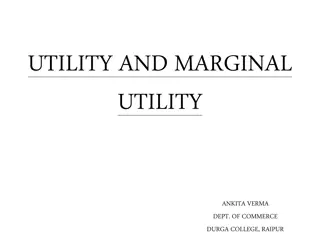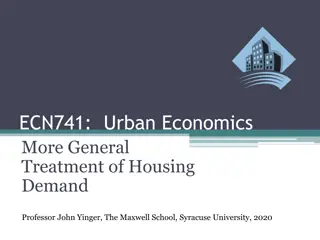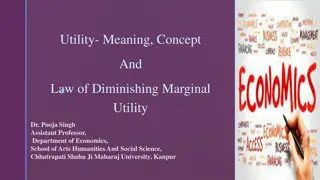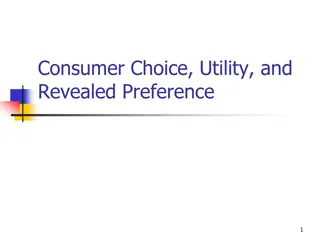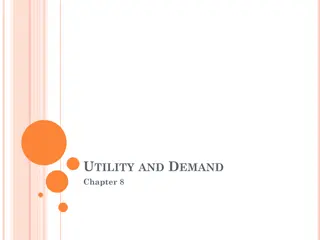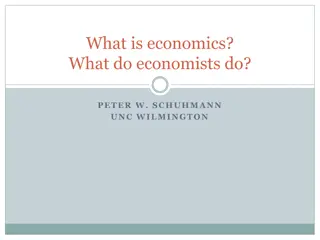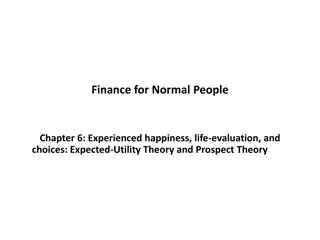Understanding Utility Theory in Economics
Utility theory in economics explores the concept of utility, which refers to the satisfaction or want-satisfying capacity a commodity provides to consumers. It is subjective, relative, and can vary among individuals. Cardinal utility analysis quantifies utility in numbers, while total utility and marginal utility measure the overall satisfaction derived from consuming commodities. The level of utility can change based on place and time, and individuals may have different preferences for the same commodity.
Download Presentation

Please find below an Image/Link to download the presentation.
The content on the website is provided AS IS for your information and personal use only. It may not be sold, licensed, or shared on other websites without obtaining consent from the author. Download presentation by click this link. If you encounter any issues during the download, it is possible that the publisher has removed the file from their server.
E N D
Presentation Transcript
Topic to be covered Dr. Bharti Shukla Assistant Professor MSD MMMUT, GKP 1. Utility 2. Cardinal Utility 3. Law of Diminishing Marginal Utility 4. Ordinal Utility 5. Indifference Curve Analysis
A consumer usually decides his demand for a commodity on the satisfaction) that he derives from it. What is utility? basis of utility (or Consumer Theory Utility of a commodity is its want-satisfying capacity. The more the need of a commodity or the stronger the desire to have it, the greater is the utilityderived fromthe commodity.
Utility is subjective. Different individuals can get different levels of utility from the same commodity. For example, some one who likes chocolates will get much higher utility from a chocolate than some one who is not so fond of chocolates, About Utility Also, utility that one individual gets from the commodity can change with change in place and time. For example, utility from the use of a room heater will depend upon whether the individual is in Ladakh or Chennai (place) or whether it is summer orwinter (time).
1. Subjective 2. It is relative 3. Does not state usefulness Features 4. No ethical, legal or moral connotations
Cardinal utility analysis assumes that level of utility can be expressed in numbers. For example, we can measure the utility derived from a shirt and say, this shirt gives me 50 units of utility. Before discussing further, it will be useful to have a look at two important measures of utility. Cardinal utility
Total Utility: Total utility of a fixed quantity of a commodity (TU) is the total satisfaction derived from consuming the given amount of some commodity x. More of commodity x provides more satisfaction to the consumer. TU dependson the quantity of the commodity consumed. Therefore, TUn refers to total utility derived from consuming n units of a commodity x. Marginal Utility: Marginal utility (MU) is the change in total utility due to consumption of one additional unit of a commodity. For example, suppose 4 bananas give us 28 units of total utility and 5 bananas give us 30 units of total utility. Clearly, consumption of the 5thbanana has caused total utility to increase by 2 units (30 units minus 28 units). Therefore, marginal utility of the 5thbanana is 2 units. MU5 = TU5 TU4 = 30 28 = 2 Measurement of Utility
Units Total Utility Marginal Utility 1 12 12 2 18 6 3 22 4 4 24 2 5 24 0 6 22 -2 Values of marginal and total utility derived from consumptionofvarious amountsof acommodity
The values of marginal and total utility derived consumption of various amounts of a commodity. The marginal utility diminishes with increase in consumption commodity. from of the
Notice that MU3 is less than MU2. You may also notice that total utility increases but at a Diminishing rate: The rate of change in total utility due to change in quantity of commodity consumed is a measure of marginal utility. This marginal utility diminishes with increase in consumption of the commodity from 12 to 6, 6 to 4 and so on. This follows from the law of diminishing marginal utility. MU becomes zero at a level when TU remains constant. In the example, TU does not change at 5th unit of consumption and therefore MU = 0. Thereafter, TU starts falling and MU becomes negative. Explanation of Utility Table and Diagram
Law of Diminishing Marginal Utility states that marginal utility from consuming each additional unit of a commodity declines as its consumption increases, while keeping consumption of other commodities constant. Law of Diminishing Marginal Utility
1. Units should be homogeneous 2. Consumed in quick succession 3. Standard in size 4. Taste should be constant Assumptions 5. No change in price of substitute 6. Utility is measurable 7. Consumer is expected to be rational
1. Dissimilar units 2. Too long an interval 3. Abnormal People Limitations 4. Rare Collection 5. Not Applicable to Money



